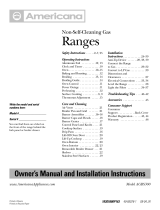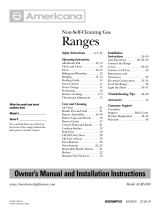Customer Service Troubleshooting Tips Installation Instructions Care and Cleaning Operating Instructions Safety Instructions
6
IMPORTANT SAFETY INFORMATION.
READ ALL INSTRUCTIONS BEFORE USING.
WARNING!
SURFACE COOKING UNITS
Use proper pan size—Avoid pans that are unstable or easily tipped. Select cookware having flat
bottoms large enough to properly contain food and avoid boilovers and spillovers and large enough to
cover burner grate. This will both save cleaning time and prevent hazardous accumulations of food,
since heavy spattering or spillovers left on range can ignite. Use pans with handles that can be easily
grasped and remain cool.
■Always use the
LITE
position (on electric
ignition models) or the
HI
position (on
standing pilot models) when igniting top
burners and make sure the burners have
ignited.
■Never leave surface burners unattended
at high flame settings. Boilover causes
smoking and greasy spillovers that may
catch on fire.
■Adjust the top burner flame size so it
does not extend beyond the edge of the
cookware. Excessive flame is hazardous.
■Use only dry pot holders—moist or damp
pot holders on hot surfaces may result in
burns from steam. Do not let pot holders
come near open flames when lifting
cookware. Do not use a towel or other
bulky cloth in place of a pot holder.
■To minimize the possibility of burns,
ignition of flammable materials, and
spillage, turn cookware handles toward the
side or back of the range without extending
over adjacent burners.
■Always turn the surface burner to
OFF
before removing the cookware.
■Carefully watch foods being fried at a high
flame setting.
■Never block the vents (air openings) of the
range. They provide the air inlet and outlet
that are necessary for the range to operate
properly with correct combustion. Air
openings are located at the rear of the
cooktop, at the top and bottom of the oven
door, and at the bottom of the range under
the broiler drawer.
■Foods for frying should be as dry as
possible. Frost on frozen foods or moisture
on fresh foods can cause hot fat to bubble
up and over sides of the pan.
■Use least possible amount of fat for effective
shallow or deep-fat frying. Filling the pan
too full of fat can cause spillovers when
food is added.
■When flaming foods under the hood,
turn the fan on.
■If a combination of oils or fats will be used
in frying, stir together before heating or as
fats melt slowly.
■Always heat fat slowly, and watch as it heats.
■Use a deep fat thermometer whenever
possible to prevent overheating fat beyond
the smoking point.
■When using glass cookware, make sure it is
designed for top-of-range cooking.
■Keep all plastics away from top burners.
■Do not leave plastic items on the cooktop—
they may melt if left too close to the vent.
■Do not leave any items on the cooktop. The
hot air from the vent may ignite flammable
items and will increase pressure in closed
containers, which may cause them to burst.
■To avoid the possibility of a burn, always be
certain that the controls for all burners are
at the
OFF
position and all grates are cool
before attempting to remove them.
■Should you have a grease fire, turn the fan
off. The fan, if operating, may spread the
flames.
■If range is located near a window, do not
hang long curtains that could blow over
the top burners and create a fire hazard.
■When a pilot goes out (on standing pilot
models), you will detect a faint odor of gas
as your signal to relight the pilot. When
relighting the pilot, make sure burner
controls are in the
OFF
position, and follow
instructions in this manual to relight.
■If you smell gas, and you have already made
sure pilots are lit (on standing pilot
models),turn off the gas to the range and
call a qualified service technician. Never
use an open flame to locate a leak.
■Keep range clean and free of accumulations
of grease or spillovers, which may ignite.
■Be careful when you clean the cooktop
because the area over the pilot (on standing
pilot models) will be hot.





















